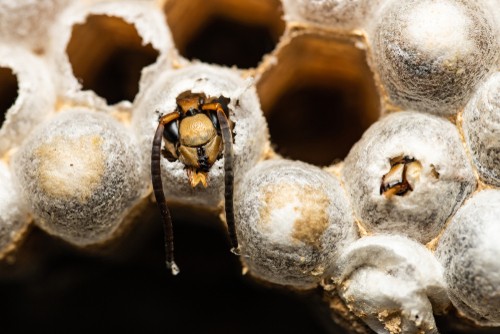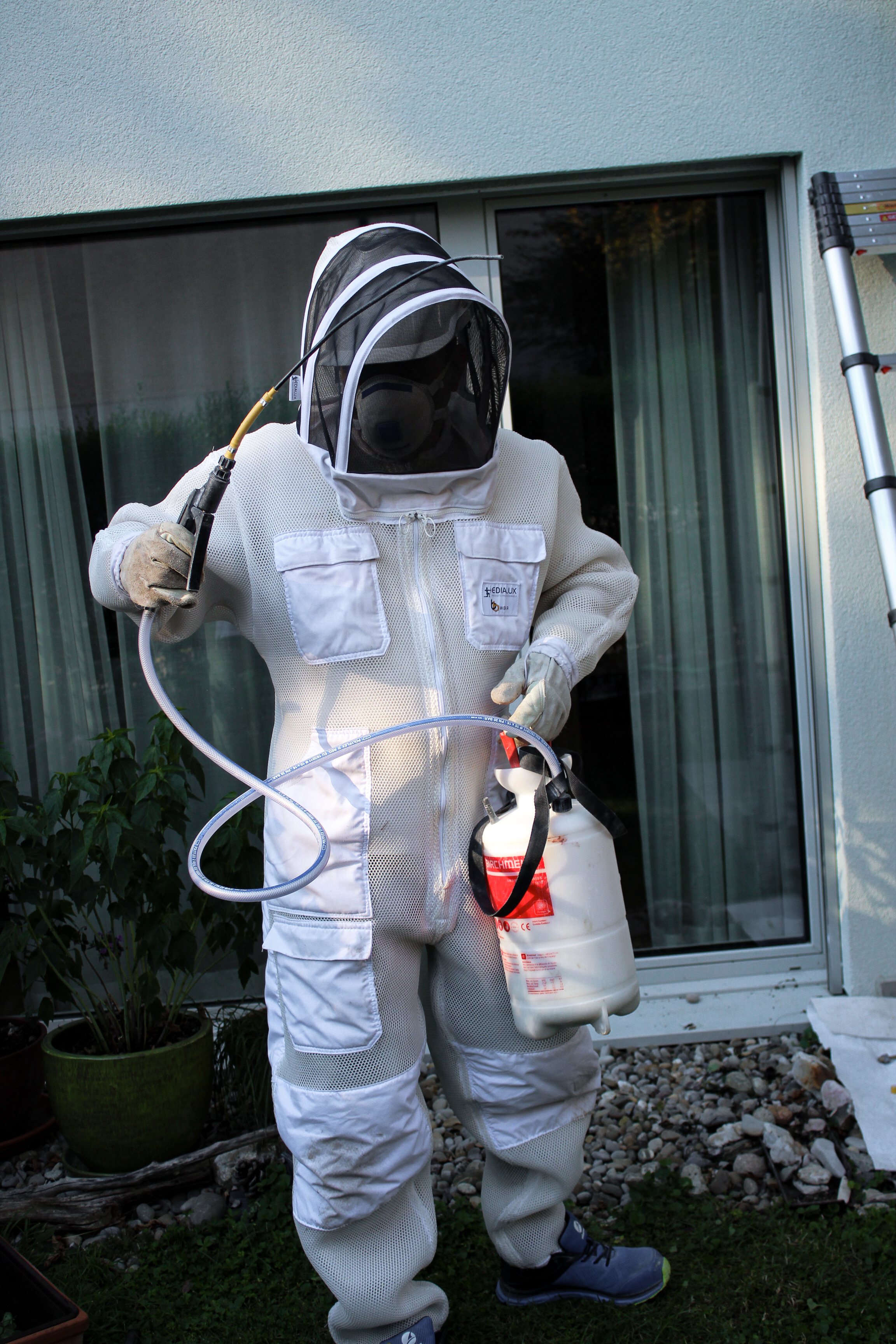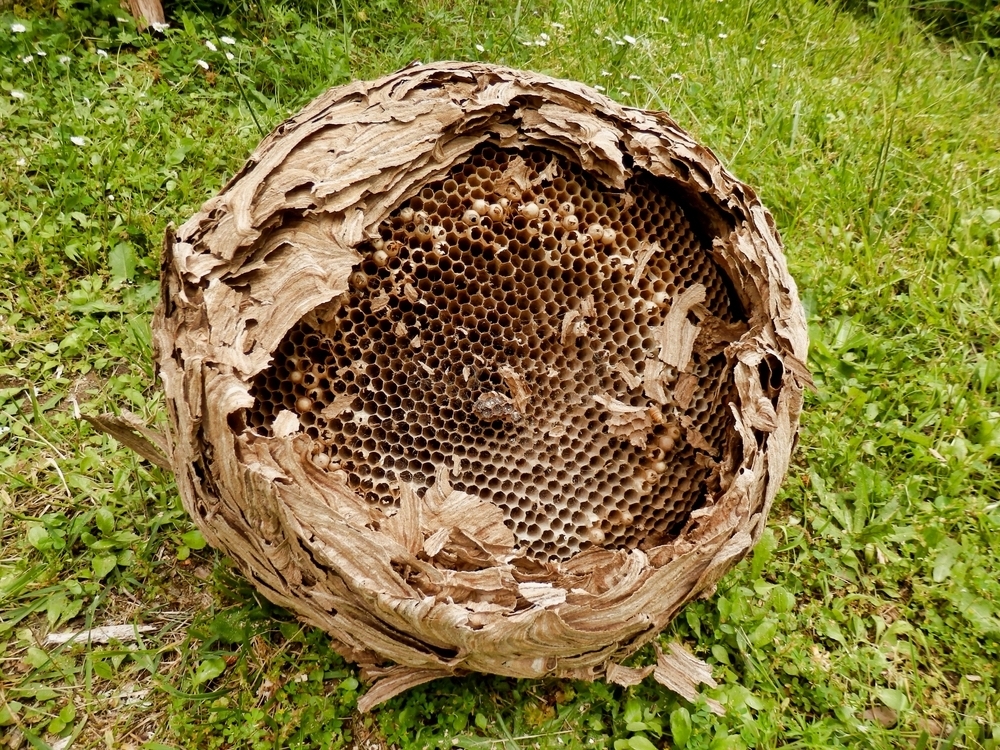
Asian hornet in Switzerland
Contact us now: 058 510 22 54
Asian hornet Vespa velutina report
Vespa velutina is a species of hornet native to South East Asia, which is now spreading invasively to Switzerland and the entire subcontinent. They are not aggressive towards humans, but are a known predator of honey bees, which is causing concern among beekeepers. A small team of hornets can attack and destroy an entire colony of bees within a few hours. If you have discovered a hornet's nest on your house, patio, shed or in your blind box, contact our experts!
Use the uncomplicated telephone service of the Hornet Experts and simply contact us at 058 510 22 54, we are your contact for professional hornet nest removal in Switzerland.


Appearance of the Asian hornet
Here are some characteristics that distinguish the Asian hornet:
1. Size: The queen can reach a length of about 3 cm, while the workers are slightly smaller and measure about 2.5 cm.
2. Color: The Asian hornet has a dark body that is almost black, with a yellow stripe at the back of the abdomen. Its face is orange-yellow.
3. Wings: The wings are dark and almost smoky gray.
4. Legs: The hornet has yellow tips on its legs, which is a striking distinguishing feature when it flies.
5. Nest: The Asian hornet's nest is often high in the trees, but it can also be found underground or in tall structures such as chimneys. It has an oval shape and is made of chewed wood, which gives the hornet a papery texture.
It is important to distinguish the Asian hornet from the European hornet (Vespa crabro), which is more harmless and a natural part of the European fauna. If you suspect you have found an Asian hornet's nest in your area, you should report it to the local authorities as they can spread quickly and be harmful to bees and other insects. To avoid being attacked by the flying inhabitants, you should hire a professional pest controller such as the Hornet Experts. We can identify the nest beyond doubt and take further steps to remove the Asian hornets professionally.
News about the Asian hornet

02.12.2025 Western Switzerland: Killer hornet eats bees
The territory of the Asian killer hornet has expanded considerably this year, with a notable increase reported in western Switzerland. This invasive species poses a significant threat to native bee populations, as bees make up the majority of its diet. The potential consequences are serious. Moreover, the hornet represents a danger to individuals with allergies to its venom.

25.11.2025 Serious concerns about the bee population!
Asian hornets are inflicting significant harm on beehives across multiple parts of Europe, as reported by local beekeepers. Even a small number of hornets can destroy an entire bee colony within hours. This sharp decline in pollinators could have serious consequences for pollination, local ecosystems, and agricultural productivity.

18.11.2025 Asian hornet doesn't just eat bees!
The danger it presents to insects is substantial!
The Asian hornet feeds largely on honeybees—up to 85 percent of its diet—alongside beetles and flies. This high level of predation not only poses difficulties for fruit growers but also further threatens already vulnerable bee populations.

11.11.2025 How did the Asian hornet get to Europe?
The Asian hornet likely arrived in Europe unintentionally and has quickly expanded throughout France and nearby countries. Its adaptability to different environments and the absence of natural predators have contributed to its rapid spread. A single nest can generate several hundred new queens in one breeding season.
Recognizing the Asian Hornet Nest: Features and Location
The nest of the Asian hornet (Vespa velutina) has some characteristic features:
1. shape and size: The nests usually have an oval to spherical shape. In the initial phase, they are small, but can grow considerably over time, sometimes even up to the size of a basketball or larger.
2. Color and material: The nests are made of chewed wood and plant material, which gives them a papery texture. They are often gray or brown.
3. structure: The outer shell of the nest is covered with several layers of chewed wood that provide protection. There is often only one central entrance hole, usually located at the bottom of the nest.
4. Location: While the Asian hornet often builds its nests in trees at a certain height, they can also be found in bushes, under roof overhangs, in sheds or other sheltered places.
5. Activity: If you observe a significant number of hornets in a particular area, especially if they regularly fly in and out of a particular area, this could be an indication of a nest nearby.
If you suspect an Asian hornet nest, you should keep a safe distance and try not to disturb it as the hornets can become aggressive if they feel threatened. It is advisable to contact a local specialist company like us to safely remove or treat the nest, especially in areas where the Asian hornet is considered an invasive pest. If you would like the hornet's nest removed immediately, simply give us a call or arrange your preferred appointment online.
How dangerous is the Asian hornet?
The Asian hornet (Vespa velutina) is a predatory insect that originated in Asia and has spread in recent years to various parts of Europe, including France and now Switzerland. Although it poses a threat to honey bees and native biodiversity, it is generally no more dangerous to humans than other wasp species. Nevertheless, there are some aspects to be aware of:
1. Threat to honey bees: The Asian hornet preys on honey bees, threatening native bee populations. A decline in bees can have a negative impact on pollination and thus on local flora and agricultural production.
2. Stings: As with other wasp and hornet species, the stings of the Asian hornet can also be painful. For most people, the stings are unpleasant but not dangerous. However, people who are allergic to wasp or hornet stings can suffer a severe allergic reaction, which in the worst case can lead to anaphylactic shock.
3. Aggressiveness: Although the Asian hornet is not necessarily more aggressive towards humans than other wasp species, it can become aggressive if it feels threatened, especially near its nest.
4. Ecological effects: Apart from the direct effects on honey bees, the spread of the Asian hornet can also disturb the ecological balance by affecting the populations of other insects.
It is important to note that the Asian hornet should not be confused with the Asian giant hornet (*Vespa mandarinia*), which is significantly larger and is known as the "killer hornet". The giant hornet is potentially more dangerous to humans due to its more powerful venom and the size of its sting.
If you have discovered a nest, call us immediately: 058 510 22 54
OUR HORNET PROFESSIONALS ARE CERTIFIED BY THE FEDERAL CERTIFICATE OF COMPETENCE.
Contact form Asian hornet
Please fill out all required fields and submit the form.
Help us!
If you discover an Asian hornet or a nest of this invasive species, it is of the utmost importance that you report it immediately. The Asian hornet is not only dangerous to humans, but also poses a serious threat to native bee populations and the ecological balance in Switzerland.
Why is it important to report the find?
The Asian hornet has a significant impact on native insects, especially honey bees, in regions where it has become established. They prey on bees, which can lead to a decline in pollinator populations, affecting local flora and agricultural production. By reporting sightings, experts can react quickly, remove the hornets or their nests and thus prevent the spread of this invasive species.
Notification form for sightings
In order to regulate the overpopulation of the Asian hornet in Switzerland and protect our native insect populations, we urge you to report any suspicions or sightings using our special reporting form. With your help, we can intervene at an early stage and minimize the spread of this dangerous species in our ecosystems.
Your contribution is crucial in the fight against the Asian hornet in Switzerland. Together we can protect nature and maintain the balance of our ecosystems.
Thank you for your vigilant attention and your commitment to protecting our environment.
6 tips if you have discovered an Asian hornet nest
Dealing with an Asian hornet nest can be dangerous, as the hornets can become aggressive if they feel themselves or their nest is threatened. Here are some tips on how to deal with such a nest safely and effectively:
1. Do not remove yourself: Never try to remove or destroy the nest yourself. This can lead to numerous stings, which are painful and can cause allergic reactions.
2. Safe distance: Always keep a safe distance from the nest. Observe it from a safe distance and don't let curiosity tempt you to look at it up close.
3. Notify experts: In many areas, there are specialized service providers or authorities who are familiar with the removal of hornet nests. Contact them to ensure that the nest is removed professionally and safely.
4. Warn others: If the nest is in a publicly accessible area, warn others, especially children, of the danger. If possible, mark the area to ensure that no one accidentally gets too close.
5. Avoid loud noises and fast movements: Hornets can be provoked by loud noises or fast movements near their nest. Avoid lawn mowing, hedge trimming or other loud activities near the nest.
6. Educate yourself about the Asian hornet: The more you know about the Asian hornet, the better prepared you can be for an encounter. There are many resources online and in local libraries that provide information about these insects.
If you are stung, treat the sting as quickly as possible. In the event of multiple stings, allergic reactions or stings in the mouth or throat area, you should consult a doctor immediately. It is also advisable to always have a first aid kit with you in areas with a high incidence of Asian hornets.
Frequently Asked Questions About Asian Hornets
The Asian hornet is classified as an insect that carries the potential risk of severe and even fatal stings. Compared to most other hornet species, it is significantly more dangerous.
The Asian hornet is a large, stinging insect that can reach a length of up to 3 cm. Its body is narrow and black, covered by a dense coat of orange, yellow and black.
Normally, the Asian hornet is rather shy and passive. However, if it feels threatened and sees no possibility of escape, it can become extremely active and aggressive in order to defend itself.
The venomous Asian hornet can cause severe pain and trigger allergic reactions in humans when it bites.
The Asian hornet poses a danger as it has a poisonous sting that can cause both painful and allergic reactions compared to other wasp species.
To report an Asian hornet, you should contact a regional wild bee conservation officer or a local Department of Agriculture agency.
It is very important to report the presence of Asian hornets in order to prevent possible attacks and curb the spread of this insect species. This species is characterized by its territorial behaviour and aggressiveness.
It is advisable to use a pest control service to carry out professional hornet control in Switzerland, especially if you have Asian hornets.
In Switzerland, it is advisable to have professional hornet control carried out if you have Asian hornets. It is advisable to hire a pest control company.
The Asian hornet hibernates either in groups or alone in various hiding places such as the corners of walls, buildings, garden sheds, chance houses or tree hollows.
Would you like more information about Asian hornets? Then take a look at our FAQ's about Asian hornets.
Private inquiry form
For an uncomplicated inquiry about removing an Asian hornet's nest use our contact form for private individuals.
Real estate inquiry form
Use our order form as a property manager to request the removal of an Asian hornet's nest.




.jpeg)
.jpeg)
.jpeg)
.jpeg)

